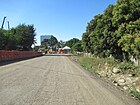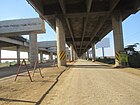Candaba Viaduct
Candaba Viaduct | |
|---|---|
 | |
| Coordinates | 14°57′15″N 120°46′36″E / 14.9542°N 120.7767°E |
| Carries | 6 lanes of |
| Crosses | Candaba Swamps Pampanga River |
| Locale | Apalit, Pampanga Calumpit, Bulacan Pulilan, Bulacan |
| Official name | Candaba Viaduct |
| Other name(s) | Pulilan-Apalit Bridge Candaba Pampanga Viaduct (STA 46+938 – 52+188) |
| Maintained by | NLEX Corporation (Tollways Management Corporation) |
| Characteristics | |
| Design | Viaduct |
| Material | Concrete, asphalt |
| Total length | 5 km (3.1 mi) |
| Width | 12 m (39 ft) per direction |
| Height | 15 m (49 ft 3 in) |
| No. of lanes | Six-lane double carriageway (three lanes per direction) |
| History | |
| Designer | Aas-Jakobsen[1] |
| Constructed by | Philippine National Construction Corporation[2] Leighton Asia (third bridge) |
| Construction start | 1974 |
| Construction end | 1976 |
| Opened | 1977 |
| Statistics | |
| Toll | See NLEX toll matrix |
| Location | |
 | |
The Candaba Viaduct (also known as Pulilan–Apalit Bridge and Candaba Pampanga Viaduct) is a 5-kilometer (3.1 mi) viaduct carrying the North Luzon Expressway (NLEX) across the Candaba Swamp in the provinces of Pampanga and Bulacan, Philippines consisting of six lanes (three northbound and three southbound). It was the longest bridge in the Philippines upon its opening in 1976, surpassed in October 5, 2021 by the 8.9 km Cebu–Cordova Link Expressway (CCLEX) upon its inauguration making the viaduct now the second longest bridge in the country. The viaduct was designed by Aas-Jakobsen and built by Construction Development Corporation of the Philippines (CDCP, later renamed to Philippine National Construction Corporation) as part of construction of the whole NLEX.[2][1] [3]
Overlooking Mount Arayat in the east and Zambales Mountains in the west, the viaduct is raised over Candaba Swamp, which keeps the highway open to traffic, even when the swamp gets flooded during the rainy or monsoon season.[4] Lighting, emergency callboxes and CCTVs along the viaduct are powered by solar panels due to the problem of installing power lines within the viaduct.[5]
Route description[edit]

The Candaba Viaduct passes over Candaba Swamp and adjacent Pampanga River and connects the provinces of Pampanga and Bulacan.[3] Most of its portions are lined with billboards, rice paddies, and some trees.
The viaduct starts at Barangay Dulong Malabon in Pulilan where there are a few houses located under it and after a few meters, it enters the municipality of Calumpit. It enters Pampanga (Apalit) upon approaching a lay-by located before passing an area with palm trees and continues on a straight route. It then passes through Apalit Bypass Road (with no junction or exit to serve the bypass road) and Pampanga River, by which the parish church is located, visible from the road. A footbridge is located on its southbound lane. The bridge ends after crossing Pampanga River.
History[edit]
In 1973, the 50-kilometer extension of the expressway began construction, and in 1974, the viaduct was constructed, which was initially a single bridge. The whole stretch of NLEX was constructed as a component project of the International Bank for Reconstruction and Development under the direction of the Ministry of Public Highways.[2] The project was completed in 1977 and through Presidential Decree No. 1113, then President Ferdinand Marcos granted CDCP the franchise to maintain and operate the NLEX including the Candaba Viaduct.[6]
The second bridge became accessible to motorists in 1978.[7]
The operations and maintenance of the whole of NLEX, including Candaba Viaduct, were transferred to NLEX Corporation on February 10, 2005.[8]
In February 18, 2008, the then operator of the Philippine power grid and its related assets and facilities National Transmission Corporation (TransCo), a government-owned corporation under the Department of Energy (DOE), granted permission from NLEX Corporation, and Apalit, Calumpit and Pulilan local government units (LGUs) to acquire and designate lands for the 18 lattice towers of relocated San Simon–Pulilan section of Hermosa–Duhat–Balintawak transmission line (255–282), with Candaba Viaduct being the right-of-way (ROW) for the towers. However, due to the turnover of power grid operations and maintenance to privately-owned National Grid Corporation of the Philippines (NGCP) on January 15, 2009, only four lands and structures, and two ROWs for the lattice towers were acquired and designated, and under the original TransCo plan and component of the relocation project that are currently in use (towers 255, 256, 266, and 267). On late 2009 months after the turnover of power grid O&M from TransCo to NGCP to March 25, 2011, NGCP made the acquisition and designation of lands and 2 ROWs for the 22 steel poles (poles 257–265, 268–280), under NGCP's revised plan and component of the project, and on locations and alignment or route different from the original TransCo one, still with the permission from NLEX Corporation and the said LGUs to run parallel with the viaduct.[9]
In February 2017, it was announced that Candaba Viaduct would be expanded and would have a third lane on both sides of the bridge.[10]
NGCP granted permission from NLEX Corporation and Calumpit LGU to intersect its Hermosa–San Jose 500,000-volt line on the viaduct's Calumpit section in 2021.
In February 2023, Leighton Asia was given the construction contract for the third bridge, and in April of the same year, the 5.3-kilometer (3.3 mi) Third Candaba Viaduct was started to be built between the viaduct's northbound and southbound lanes. It is built to unload some of the weight passing through the existing bridges. It intersects the Apalit-Balucuc-Tabuyuc Bypass Road and is expected to be completed in November 2024. 2x3 lanes without shoulders is being constructed, from 3 lanes without shoulder to 3 lanes with inner and outer shoulders in each direction which increases speed from 60 to 80 kms. per hour, using green and sustainable engineering practices. It will have piers at every 20 meters each supported by 2 columns and 2 bored piles that will strengthen the structure.[11][12][13]
As of February 2024, the construction of the Third Candaba Viaduct is 50% complete. Jose Luigi L. Bautista signed a ₱10 billion loan agreement with the Bank of the Philippine Islands (BPI) for funding to ensure its completion in November 2024.[14] The NLEX Corporation on February 26, 2024 said that the successful first girder installation marked the transition from heavy groundwork construction to road-level work. The project reached the halfway mark a significant milestone. [15]
- Third Candaba Viaduct Construction
-
Pulilan NLEx access road
-
Third Candaba Viaduct in February, 2024
-
Bored piles, columns, crossheads and girders Dulong Malabon
In popular culture[edit]
This bridge is the reference in a joke, "Mula sa kabila, itlog. Pagtawid naging 'ibon' na sa haba ng tulay" (transl. "From the other end, was still an egg. When they reached the other end, it became a 'bird' due to the bridge's length"). It is because the Kapampangan word for egg is "ebun".[16][17][18]
See also[edit]
References[edit]
- ^ a b "Candaba Viaduct". Structurae. Retrieved March 2, 2017.
- ^ a b c "PNCC Projects". Philippine National Construction Corporation. Retrieved February 24, 2022.
- ^ a b Dy, Rolando T. (August 30, 2016). "Bridges for Development". BusinessWorld (Opinion). Archived from the original on July 14, 2018. Retrieved March 2, 2017.
- ^ Kakabadse, Yolanda (May 20, 2014). "How to Prepare for Our Future Climate". World Economic Forum. Retrieved February 24, 2022.
- ^ Remo, Amy R. (August 9, 2011). "Solar-Powered Lamp Posts Eyed for NLEx". Inquirer.net. Retrieved February 24, 2022.
- ^ Presidential Decree No. 1113 – via The Lawphil Project.
- ^ "My father, the builder". Philstar Life. Retrieved May 19, 2024.
- ^ "Our Company". Philippine National Construction Corporation. Retrieved February 24, 2022.
- ^ National Grid Corporation of the Philippines. "NGCP 2009 Transmission Development Plan" (PDF). Department of Energy. Retrieved May 24, 2024.
- ^ "P2.6b Nlex Expansion in the Offing". Manila Standard. February 23, 2017. Archived from the original on March 3, 2017. Retrieved March 3, 2017.
- ^ "NLEX signs deal with Leighton for Candaba 3rd Viaduct". Zigwheels. Retrieved May 19, 2024.
- ^ "NLEx operator eyes November 2024 opening for third viaduct in Candaba". INQUIRER.net. June 22, 2023. Retrieved January 27, 2024.
- ^ Rosales, Elijah Felice. "NLEX to invest P8 billion for 3rd Candaba viaduct". Philstar.com. Retrieved January 27, 2024.
- ^ De Leon, Jovi (January 12, 2024). "3rd Candaba viaduct 30.58% complete". SunStar.
- ^ "NLEX Corporation reaches the halfway mark for Candaba 3rd Viaduct project". AutoIndustriya.com. February 26, 2024. Retrieved February 27, 2024.
- ^ Ocampo, Ambeth R. (October 22, 2013). "Boom tarat tarat!". INQUIRER.net. Retrieved January 27, 2024.
- ^ Jr, Federico D. Pascual. "Crossing a river, their 'itlog' turns into 'ebun'". Philstar.com. Retrieved January 27, 2024.
- ^ Ocampo, Ambeth R. (June 30, 2023). "History on the tongue". INQUIRER.net. Retrieved January 27, 2024.
External links[edit]
![]() Media related to Candaba Viaduct at Wikimedia Commons
Media related to Candaba Viaduct at Wikimedia Commons



